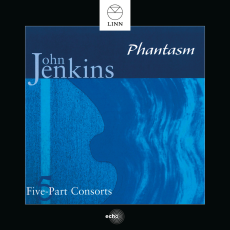Phantasm - Jenkins: Five-Part Consorts - MusicWeb International
Looking at the CDs already produced by this wonderful group of viol players (Phantasm), you will notice that in 2005 they recorded Jenkins' six-part consorts, fantasies and pavans. They have also tackled Purcell as well as much earlier repertoire. It is good indeed that they have now turned their attention to these even more complex works, written probably in the 1620s when Jenkins was at the height of his powers.
Jenkins is a very significant figure in the history of music in Britain if not in Europe as he is a long-lived link between Byrd and Tallis and Purcell. When he was born Byrd was about fifty. When he died Purcell, by then about twenty, had written his viol fantasies and In Nomines and possibly some of his well-known church music.
Jenkins may well have spent much of his early life in the employ of the Countess of Warwick around the London area where he will have come into contact with the leading composers of his day. I suspect one may have been John Coperario, a considerable composer for viols and another the great Thomas Tomkins. At the other end of his life he worked in Norfolk for the family of Sir Philip Wodehouse where, at Kimberly, an epitaph for him can still be found, saying:-
‘Under this stone rare Jenkyn's lies
The Master of the Musick Art'
And this chimes in with Laurens Dryfus, the founder of Phantasm who ends his detailed and fascinating notes for this CD by saying "Let me come straight out with it: Jenkins is a marvel."
Jenkins then can be seen as a successor in the line of the English school of polyphonists; certainly his counterpoint is extraordinary and masterly. But he is also is a contemporary of the more ‘modern' sounding though shorter-lived, William Lawes who was an innovator and had a curiously bizarre turn of mind. Jenkins is not immune from this new style nor is he immune from some aspects of French music which had percolated across the Channel during the reign of Charles I. Put this lot together and you have a potent and varied mix, here superbly captured.
I have listed the Fantasies above in the order in which they occur on the disc. I wonder why they were not presented in numerical order. If it's for the sake of contrast then, I would argue that very few will listen to the entire CD from start to finish in one sitting. It can't be for key contrast because no less than five Fantasies based around D follow in succession (8-12). Anyway, one can programme a disc for oneself in any old order. I chose to listen to them in numerical order in the belief, not entirely unjustified, that it might well have been practically the order in which Jenkins wrote them. Indeed perhaps this is also the order in which he intended us to see and play them. All of the Fantasies are offered here and three Pavans which are randomly spaced around them. The disc ends, rather bizarrely, with the third Pavan.
Dreyfus highlights and gently analyses a few pieces in his notes as exemplars. It gives you an idea what you might hear. Let us take a piece which he highlights: Fantasy No. 8. He calls this colourfully "a morose work"! in D minor "plagued by indecision". Dreyfus talks of its "uncomfortably similar themes" which the composer has to work around. Treated imitatively and winding from bottom to top, the initial idea is played in all registers. The music ‘wanders' in semi-quaver passages but still the opening persists. Eventually, rising ever-higher, new lines are introduced and the music seems to be "perpetually distressed". The second half of the Fantasy from 1.56 "is devoted to a new theme" but which is still melancholy with the ideas "drawn from vocal polyphony"; an astute judgement this. Nicely contrasted with this is a jolly Fantasy in D major, more jig-like. These two together reminded me of a contrasted Pavan and Galliard a form which by that time was only vaguely out of fashion.
Mention should be made of these lovely and idiomatic performances. Do you remember when a viol consort was greeted with a subdued moan, and often played in a way that lacked energy? Well, think again. These performances are full of life. Do I also detect the occasional little bit of vibrato? Why not? Dynamics are created out of the rise and fall of the music and its tension and release. Super balance also, and a quite natural recording despite what I thought at first would be an unpromising venue.
I like this disc and although it might appear to be a little bit ‘niche market', if you are interested in this repertoire then this is a very good place to start.

